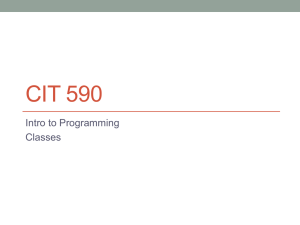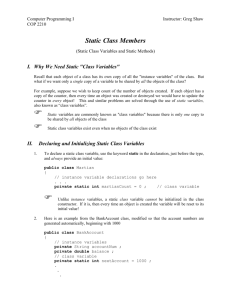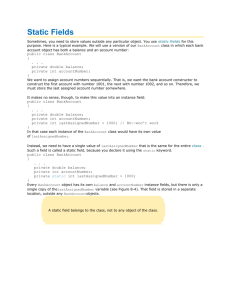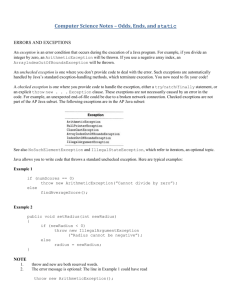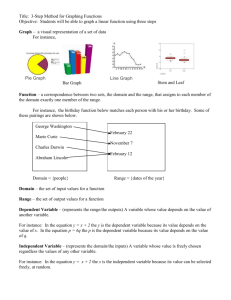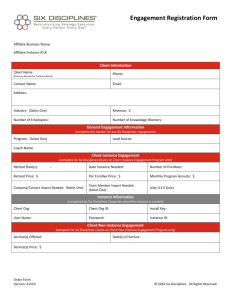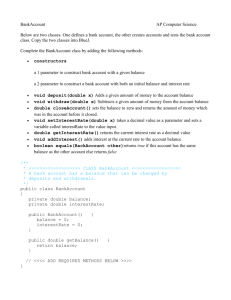09Tall
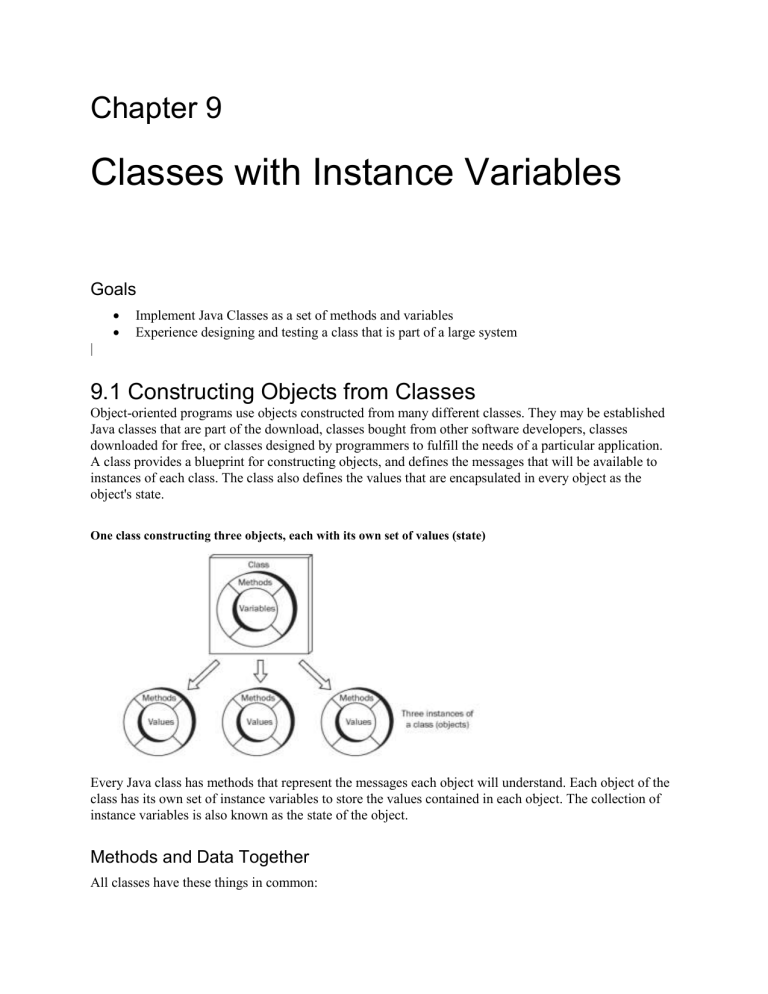
Chapter 9
Classes with Instance Variables
|
Goals
Implement Java Classes as a set of methods and variables
Experience designing and testing a class that is part of a large system
9.1 Constructing Objects from Classes
Object-oriented programs use objects constructed from many different classes. They may be established
Java classes that are part of the download, classes bought from other software developers, classes downloaded for free, or classes designed by programmers to fulfill the needs of a particular application.
A class provides a blueprint for constructing objects, and defines the messages that will be available to instances of each class. The class also defines the values that are encapsulated in every object as the object's state.
One class constructing three objects, each with its own set of values (state)
Every Java class has methods that represent the messages each object will understand. Each object of the class has its own set of instance variables to store the values contained in each object. The collection of instance variables is also known as the state of the object.
Methods and Data Together
All classes have these things in common:
107
private instance variables that store the state of the objects
constructors that initialize the state
methods to modify the state of objects
methods to provide access to the current state of objects
Java classes begin with public class followed by the class name. The instance variables and methods follow within a set of matching curly braces. The methods and state should have some sort of meaningful connection.
Simplified General Form: A Java class public class class-name {
// Instance variables (every instance of this class will get its own) private variable declaration ; private variable initialization ;
// Constructor(s) (methods with the same name as the class and no return type) public class-name ( parameters ) {
// …
}
// Any number of methods public return-type method-name-1 ( parameters) {
// …
}
}
Here is a simplified version of the BankAccount class. The two instance variables ID and balance are available to all methods of the class.
// This class models a minimal bank account.
public class BankAccount {
// Instance variables--every BankAccount object will have its own values.
private String ID ; private double balance ;
// Initialize instance variables during construction.
public BankAccount(String initialID, double initialBalance) {
ID = initialID;
balance = initialBalance;
} public void deposit( double depositAmount) {
balance = balance + depositAmount;
} public void withdraw( double withdrawalAmount) {
balance = balance - withdrawalAmount;
} public String getID() {
return ID;
} public double getBalance() {
108 return balance;
}
}
With the class stored in a file, it can be used as a blueprint to construct many objects. Each object will have its own ID and balance. Each object will understand the withdraw , deposit , getID , and getBalance methods. In the following program, the numbers (
for example) indicate which method will execute when the message is sent. For example, represents transfer of control from the main method to the deposit method in the BankAccount class.
@Test
public void testToDemonstrateControlFlow() {
BankAccount acctOne = new BankAccount("01543C", 100.00) ;
acctOne.
deposit(50.0) ;
acctOne.
withdraw(25.0) ;
assertEquals("01543C", acctOne.getID());
assertEquals(125.0, acctOne.getBalance(), 1e-14);
}
Instance Variables
In this first example of a type implemented as a Java class, each BankAccount object stores data to represent a simple account at a bank. Each BankAccount object stores some unique identification ID and an account balance. BankAccount methods include making deposits, making withdrawals, and accessing the ID and the current balance.
The private instance variables represent the state. BankAccount has two private instance variables: ID
(a String ) and balance (a double ). Every BankAccount object remembers its own ID and its own current balance.
Notice that the instance variables are not declared within a method. They are declared within the set of curly braces that bounds the class. This means that the instance variables will be accessible throughout the class, and every method will have access to them.
If you look at the BankAccount class again, you will notice that every method references at least one of the instance variables. Also, each instance variable is accessed by at least two methods (both the constructor BankAccount and getID need ID ).
Because the instance variables are declared private , programs using instances of the class cannot access the instance variables directly. This is good. The class safely encapsulated the state, which was initialized by the constructor (described below). The only way to then change or access the state of an object is through public methods.
Constructors
The BankAccount class shows that all BankAccount method headings are public. They also have return types (including void to mean return nothing). Some have parameters. However, do you notice something different about the method named BankAccount ?
The BankAccount method has no return type. It also has the same name as the class! This special method is known as a constructor, because it is the method called when objects are constructed. When a constructor is called, memory is allocated for the object. Then, the instance variables are initialized, often with the arguments to the constructor. Here are some object constructions that result in executing the class’s constructor while passing values: new String( "An initial part of this object's state" );
new BankAccount( "Charlie" , 10.00);
Chapter 9: Classes
109
Constructor parameters often initialize the private instance variables. The constructor returns a reference to the new object. This reference value can then be assigned to an object reference of the same type. That is why you often see the class name on both sides of the assignment operator = . For example, the following code constructs a BankAccount object with an initial ID of "Phoenix" and an initial balance of
507.34
. After the constructor has been called, the reference to this new BankAccount object is assigned to the reference variable named one .
BankAccount one = new BankAccount( "Phoenix" , 507.34);
The following code implements BankAccount
’s two-parameter constructor:
// This constructor initializes the values of the instance variables
// using the arguments use when objects are constructed.
public BankAccount(String accountID, double initialBalance) {
ID = accountID; balance = initialBalance;
}
This method executes whenever a BankAccount gets constructed with two arguments (a String followed by a double ). For example, in the following code, the ID "Jessie" is passed to the parameter ID , which in turn is assigned to the private instance variable ID . The starting balance of 500.00
is also passed to the parameter named initialBalance , which in turn is assigned to the private instance variable balance .
BankAccount anAccount = new BankAccount( "Jessie" , 500.00);
Some methods provide access to private instance variables. They are sometimes called “getters”, because the method "gets" the value of an instance variable (and they usually begin with get ). These methods often simply return the value of an instance variable with the return statement. Getter methods are necessary because the instance variables are not directly accessible when they are declared private .
public String getID() { return ID ;
} public double getBalance() { return balance ;
}
To get the ID and balance, send the object separate getID and getBalance messages.
@Test public void showMessagesWayAhead() {
BankAccount anAccount = new BankAccount( "Jessie" , 500.00);
assertEquals ( "Jessie" , anAccount.getID());
assertEquals (500.00, anAccount.getBalance(), 1e-14);
}
The state of an object can change. Some methods are designed to modify the values of the instance variables. Both deposit and withdraw change the state. public void deposit( double depositAmount) { balance = balance + depositAmount;
} public void withdraw( double withdrawalAmount) { balance = balance - withdrawalAmount;
}
110
These two simple test methods assert the changing state of an object.
@Test public void testDepositWithPositiveAmount() {
BankAccount anAccount = new BankAccount( "Jessie" , 500.00);
anAccount.deposit(123.45); assertEquals (623.45, anAccount.getBalance(), 1e-14);
}
@Test public void testWithdrawWithPositiveAmount() {
BankAccount anAccount = new BankAccount( "Jessie" , 500.00);
anAccount.withdraw(123.45); assertEquals (376.55, anAccount.getBalance(), 1e-14);
}
Self-Check
Use the following SampleClass to answer the Self-Check question that follows.
// A class that has no meaning other than to show the syntax of a class.
public class SampleClass {
// Instance variables private int first ; private int second ; public SampleClass( int initalFirst, int initialSecond) { first = initalFirst; second = initialSecond;
} public int getFirst() { return first ;
} public int getSecond() { return second ;
} public void change( int amount) { first = first + amount; second = second - amount;
}
} // End SampleClass
9-1 Fill in the blanks that would make the assertions pass.
// A unit test to test class SampleClass import static org.junit.Assert.*; import org.junit.Test; public class SampleClassTest {
@Test public void testGetters() {
SampleClass sc1 = new SampleClass(1, 4);
SampleClass sc2 = new SampleClass(3, 5);
assertEquals( , sc1.getFirst());
assertEquals( , sc1.getSecond());
assertEquals( , sc2.getFirst());
Chapter 9: Classes
assertEquals( , sc2.getSecond());
}
@Test public void testChange() {
SampleClass sc1 = new SampleClass(1, 4);
SampleClass sc2 = new SampleClass(3, 5);
sc1.change(7);
sc2.change(-3);
assertEquals( , sc1.getFirst());
assertEquals( , sc1.getSecond());
assertEquals( , sc2.getFirst());
assertEquals( ,sc2.getSecond());
}
}
Use this Java class to answer the questions that follow.
// A class to model a simple library book.
public class LibraryBook {
// Instance variables private String author ; private String title ; private String borrower ;
// Construct a LibraryBook object and initialize instance variables public LibraryBook(String initTitle, String initAuthor) { title = initTitle; author = initAuthor; borrower = null ; // When borrower == null, no one has the book
}
// Return the author. public String getAuthor() { return author ;
}
// Return the borrower's name if the book has been checked out or null if not public String getBorrower() { return borrower ;
}
// Records the borrower's name public void borrowBook(String borrowersName) { borrower = borrowersName;
}
// The book becomes available. When null, no one is borrowing it.
public void returnBook() { borrower = null ;
}
}
9-2 What is the name of the type above?
9-3 What is the name of the constructor?
9-4 Except for the constructor, name all of the methods.
9-5 getBorrower returns a reference to what type?
9-6 borrowBook returns a reference to what type?
9-7 What type argument must be part of all borrowBook messages?
111
112
9-8 How many arguments are required to construct one LibraryBook object?
9-9 Write the code to construct one LibraryBook object using your favorite book and author.
9-10 Send the message that borrows your favorite book. Use your own name as the borrower.
9-11 Write the message that reveals the name of the person who borrowed your favorite book (or null if no one has borrowed it).
9-12 Which of the following two assertions will pass, a, b, or both?
@Test public void testGetters() {
LibraryBook book1 = new LibraryBook( "C++" , "Michael Berman" ); assertEquals ( null , book1.getBorrower()); // a.
book1.borrowBook( "Sam Mac" ); assertEquals ( "Sam Mac" , book1.getBorrower()); // b.
}
9-13 Write method getTitle that returns the title of any LibraryBook object.
9-14 Fill in the blanks so the assertions pass.
@Test public void testGetters() {
LibraryBook book1 = new LibraryBook( "C++" , "Michael Berman" );
assertEquals ( , book1.getAuthor()); assertEquals ( , book1.getBorrower());
}
9-15 Write method isAvailable as if it were inside the LibraryBook class to return false if a
LibraryBook is not borrowed or true if the borrower is null . Use == to compare null to an object reference.
9-16 Fill in the blanks in this test method to verify getTitle works so all assertions pass.
@Test public void isAvailable() {
LibraryBook book1 = new LibraryBook( "C++" , "Berman" );
LibraryBook book2 = new LibraryBook( "C#" , "Stepp" ); assert (book1.isAvailable()); assert (book2.isAvailable());
book1.borrowBook( "Sam " );
book2.borrowBook( "Li" ); assert (book1.isAvailable()); assert (book2.isAvailable());
}
Overriding toString
Each class should have its own toString method so the state of the object can be visually inspected.
Java is designed such that all classes extend a class named Object (or each class extends a class that extends the Object class). This means all Java classes inherit the eleven methods of Object , one of which is toString . Doing nothing to a new class allows toString messages to invoke the toString method of class Object . The return string is the name of the class followed by @ followed by a code written in hexadecimal (base 16 where 10 is A and 15 is F).
Chapter 9: Classes
113
LibraryBook book1 = new LibraryBook( "C++" , "Berman" );
System.out.println(book1.toString());
Output
LibraryBook@e4457d
To get a more meaningful toString that shows the current state of any object, you can override the toString method of class Object with the same method signature. public String toString() { return title + ", borrower: " + borrower;
}
With the toString method of Object overridden to reflect the new type, the output better represents the state of the object.
@Test public void testToString() {
LibraryBook book1 = new LibraryBook( "C++" , "Michael A. Berman" );
LibraryBook book2 = new LibraryBook( "Java" , "Rick Mercer" );
book2.borrowBook( "Sam Mac" ); assertEquals ( "C++, borrower: null" , book1.toString()); assertEquals ( "Java, borrower: Sam Mac" , book2.toString());
}
Self Check
9-17 Add a toString method for the BankAccount class to show the ID followed by a blank space and the current balance. You will need the instance variables in BankAccount . public class BankAccount { private String ID ; private double balance ;
public BankAccount(String initID, double initBalance) {
ID = initID; balance = initBalance;
}
// Add toString as if it were here
}
Naming Conventions
A method that modifies the state of an object is typically given a name that indicates its behavior. This is easily accomplished if the designer of the class provides a descriptive name for the method. The method name should describe—as best as possible—what the method actually does. It should also help to distinguish modifying methods from accessing methods. Use verbs to name modifying methods: withdraw , deposit , borrowBook , and returnBook , for example. Give accessing methods names to indicate that the messages will return some useful information about the objects: getBorrower and getBalance , for example. Above all, always use intention-revealing identifiers to accurately describe what the method does. For example, don’t use foo as the name of a method that withdraws money.
public or private
?
One of the considerations in the design of any class is declaring methods and instance variables with the most appropriate access mode, either public or private . Whereas programs outside the class can access the public methods of a class, the private instance variables are only known in the class methods. For example, the BankAccount instance variable named balance is known only to the methods of the class.
On the other hand, any method declared public is known wherever the object was declared.
114
Access Mode Where the Identifier Can Be Accessed (where the identifier is visible) public In all parts of the class and anywhere an instance of the class is declared private Only in the same class
Although instance variables representing state could be declared as public , it is highly recommended that all instance variables be declared as private . There are several reasons for this. The consistency helps simplify some design decisions. More importantly, when instance variables are made private , the state can be modified only through a method. This prevents other code from indiscriminately changing the state of objects. For example, it is impossible to accidentally make a credit to acctOne like this:
BankAccount acctOne = new BankAccount("Mine", 100.00);
// A compiletime error occurs: attempting to modify private data
acctOne .balance = acctOne.balance + 100000.00; // <- ERROR or a debit like this:
// A compiletime error occurs at this attempt to modify private data
acctOne.balance = acctOne.balance - 100.00; // <- ERROR
This represents a widely held principle of software development—data should be hidden. Making instance variables private is one characteristic of a well-designed class.
Answers to Self-Check
9-1 SampleClass sc2 = new SampleClass(3, 5);
assertEquals( _ 1 , sc1.getFirst());
assertEquals( 4 , sc1.getSecond());
assertEquals( 3 , sc2.getFirst());
assertEquals( 5 , sc2.getSecond());
sc2.change(-3);
assertEquals(__ 8 , sc1.getFirst());
assertEquals( -3 , sc1.getSecond());
assertEquals( 0 , sc2.getFirst());
assertEquals( 8 , sc2.getSecond());
9-2 type: LibraryBook
9-3 constructor: LibraryBook
9-4 LibraryBook (constructor) getAuthor getBorrower borrowBook returnBook
9-5 String
9-6 nothing, it is a void return type.
9-7 String
9-8 two (both String )
9-9 LibraryBook aBook = new LibraryBook("Computing Fundamentals", "Rick Mercer");
9-10 aBook.borrowBook("Kim");
9-11 aBook.getBorrower();
9-12 both a and b pass
Chapter 9: Classes
9-13 public String getTitle() { return title ;
}
9-14 @Test
public void testGetters() {
LibraryBook book1 = new LibraryBook("C++", "Michael Berman"); assertEquals (" Michael Berman ", book1.getAuthor()); assertEquals ( null , book1.getBorrower());
}
9-15 public boolean isAvailable() { return borrower == null ;
}
9-16 Fill in the blanks in this test method to verify getTitle works so all assertions pass.
assert True (book1.isAvailable());
assert True (book2.isAvailable());
book1.borrowBook("Sam Mac");
book2.borrowBook("Sam Mac");
assert False (book1.isAvailable());
assert False (book2.isAvailable());
assertEquals("_ Sam _", book1.getBorrower());
assertEquals("_ Li __", book2.getBorrower());
9-17 public String toString() { return "" + ID + " " + balance ;
}
115
